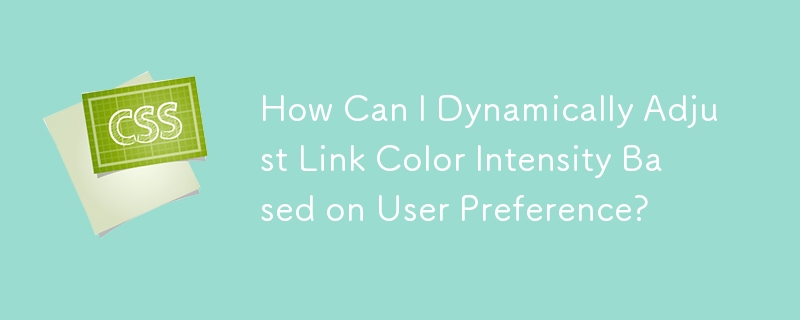 Web Front-end
Web Front-end
 CSS Tutorial
CSS Tutorial
 How Can I Dynamically Adjust Link Color Intensity Based on User Preference?
How Can I Dynamically Adjust Link Color Intensity Based on User Preference?
How Can I Dynamically Adjust Link Color Intensity Based on User Preference?

Dynamically Adjust Link Color Intensity Based on User Preference
In web development, customizing user experiences often involves allowing users to choose their preferred color schemes. However, altering link colors dynamically based on user input can be challenging. This article provides a solution using CSS filters to modify the intensity of colors, allowing developers to create customizable color schemes for their applications.
The Issue: Altering Link Intensity Manually
In CSS, specifying color using hex codes or named colors is straightforward. However, reducing the intensity of a color by a percentage is not natively supported. Attempting to use CSS syntax like "color: blue -50%;" or "color: -50%;" will result in invalid code.
Solution: CSS Filters
Modern browsers support CSS filters, which offer the ability to modify various visual properties of elements, including their brightness. Using the "brightness" filter, developers can adjust the intensity of colors:
.button {
color: #ff0000;
}
/* Adjust the value to control brightness. 100% is baseline (no change),
values below 100% darken the color, and values above 100% lighten it.*/
.button:hover {
filter: brightness(85%);
}In this example, the ".button" class initially sets the color to red. On hover, the ":hover" state applies a filter that reduces the brightness to 85%, resulting in a slightly darker shade of red. This approach allows developers to dynamically adjust the color intensity of elements based on user interactions or preferences.
By leveraging CSS filters, web developers can provide users with customizable color schemes without the need for manual hex code adjustments, enhancing the user experience and flexibility of their applications.
The above is the detailed content of How Can I Dynamically Adjust Link Color Intensity Based on User Preference?. For more information, please follow other related articles on the PHP Chinese website!

Hot AI Tools

Undresser.AI Undress
AI-powered app for creating realistic nude photos

AI Clothes Remover
Online AI tool for removing clothes from photos.

Undress AI Tool
Undress images for free

Clothoff.io
AI clothes remover

Video Face Swap
Swap faces in any video effortlessly with our completely free AI face swap tool!

Hot Article

Hot Tools

Notepad++7.3.1
Easy-to-use and free code editor

SublimeText3 Chinese version
Chinese version, very easy to use

Zend Studio 13.0.1
Powerful PHP integrated development environment

Dreamweaver CS6
Visual web development tools

SublimeText3 Mac version
God-level code editing software (SublimeText3)

Hot Topics
 1664
1664
 14
14
 1422
1422
 52
52
 1316
1316
 25
25
 1267
1267
 29
29
 1239
1239
 24
24
 Google Fonts Variable Fonts
Apr 09, 2025 am 10:42 AM
Google Fonts Variable Fonts
Apr 09, 2025 am 10:42 AM
I see Google Fonts rolled out a new design (Tweet). Compared to the last big redesign, this feels much more iterative. I can barely tell the difference
 How to Create an Animated Countdown Timer With HTML, CSS and JavaScript
Apr 11, 2025 am 11:29 AM
How to Create an Animated Countdown Timer With HTML, CSS and JavaScript
Apr 11, 2025 am 11:29 AM
Have you ever needed a countdown timer on a project? For something like that, it might be natural to reach for a plugin, but it’s actually a lot more
 HTML Data Attributes Guide
Apr 11, 2025 am 11:50 AM
HTML Data Attributes Guide
Apr 11, 2025 am 11:50 AM
Everything you ever wanted to know about data attributes in HTML, CSS, and JavaScript.
 A Proof of Concept for Making Sass Faster
Apr 16, 2025 am 10:38 AM
A Proof of Concept for Making Sass Faster
Apr 16, 2025 am 10:38 AM
At the start of a new project, Sass compilation happens in the blink of an eye. This feels great, especially when it’s paired with Browsersync, which reloads
 How We Created a Static Site That Generates Tartan Patterns in SVG
Apr 09, 2025 am 11:29 AM
How We Created a Static Site That Generates Tartan Patterns in SVG
Apr 09, 2025 am 11:29 AM
Tartan is a patterned cloth that’s typically associated with Scotland, particularly their fashionable kilts. On tartanify.com, we gathered over 5,000 tartan
 How to Build Vue Components in a WordPress Theme
Apr 11, 2025 am 11:03 AM
How to Build Vue Components in a WordPress Theme
Apr 11, 2025 am 11:03 AM
The inline-template directive allows us to build rich Vue components as a progressive enhancement over existing WordPress markup.
 While You Weren't Looking, CSS Gradients Got Better
Apr 11, 2025 am 09:16 AM
While You Weren't Looking, CSS Gradients Got Better
Apr 11, 2025 am 09:16 AM
One thing that caught my eye on the list of features for Lea Verou's conic-gradient() polyfill was the last item:
 A Comparison of Static Form Providers
Apr 16, 2025 am 11:20 AM
A Comparison of Static Form Providers
Apr 16, 2025 am 11:20 AM
Let’s attempt to coin a term here: "Static Form Provider." You bring your HTML



